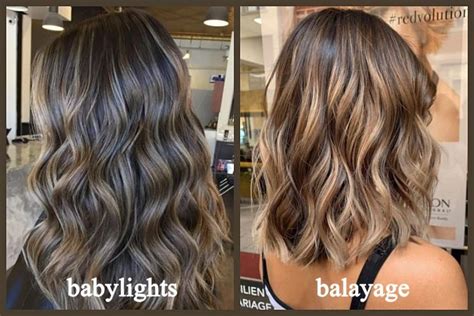What’s the Difference?
Babylights and balayage are two popular hair coloring techniques that give hair a natural, sun-kissed look. However, there are some key differences between the two techniques.

1. Application Method:
- Babylights: Babylights are applied with a fine brush, creating thin, subtle streaks of color.
- Balayage: Balayage is applied freehand, using a sweeping motion to create wider, more defined streaks of color.
2. Color Placement:
- Babylights: Babylights are typically applied close to the roots, creating a more natural look.
- Balayage: Balayage is applied mid-length to the ends, creating a more dramatic look.
3. Hair Sectioning:
- Babylights: Babylights are applied to small sections of hair, creating a more uniform distribution of color.
- Balayage: Balayage is applied to larger sections of hair, creating a more blended look.
4. Intensity of Color:
- Babylights: Babylights create a subtle, natural-looking highlight.
- Balayage: Balayage creates a more intense, dramatic highlight.
5. Maintenance:
- Babylights: Babylights require less frequent touch-ups than balayage, typically every 3-4 months.
- Balayage: Balayage requires more frequent touch-ups, typically every 6-8 weeks.
6. Cost:
- Babylights: Babylights are typically more expensive than balayage due to the time and effort involved.
- Balayage: Balayage is typically less expensive than babylights.
7. Suitability:
- Babylights: Babylights are suitable for most hair types and textures.
- Balayage: Balayage is best suited for thicker, textured hair.
Which Technique is Right for You?
The choice between babylights and balayage depends on your desired look and hair type.
Babylights are ideal for:
- Achieving a natural, sun-kissed look.
- Adding subtle dimension to your hair.
- Blending gray hairs.
- Maintaining your highlights with less frequent touch-ups.
Balayage is ideal for:
- Creating a more dramatic, lived-in look.
- Adding bolder highlights and dimension.
- Adding volume and movement to your hair.
- Achieving a more customized look.
Babylights vs. Balayage: A Comparison Table
| Feature | Babylights | Balayage |
|---|---|---|
| Application Method | Fine brush | Freehand |
| Color Placement | Close to roots | Mid-length to ends |
| Hair Sectioning | Small sections | Large sections |
| Intensity of Color | Subtle | Intense |
| Maintenance | Less frequent touch-ups | More frequent touch-ups |
| Cost | More expensive | Less expensive |
| Suitability | Most hair types | Thicker, textured hair |
Babylights vs. Balayage: A Side-by-Side Comparison
[Insert side-by-side comparison image of babylights and balayage]
Effective Strategies
- Consult with a professional hair stylist to determine which technique is right for you.
- Bring inspiration photos to your appointment to show your desired look.
- Be prepared to spend several hours in the salon for either technique.
- Follow your stylist’s instructions for aftercare to maintain the health of your hair.
Tips and Tricks
- Babylights can be customized to create a more natural or bolder look.
- Balayage can be used to create a variety of looks, from subtle highlights to dramatic ombré.
- Both babylights and balayage can be used to cover gray hairs.
- If you have fine hair, babylights are a better option as balayage can weigh hair down.
- If you have dark hair, balayage is a better option as it creates more noticeable highlights.
How to: Step-by-Step Approach
Babylights:
- Section hair into small pieces.
- Apply color to each section with a fine brush.
- Wrap each section in foil to prevent bleed.
- Process according to manufacturer’s instructions.
- Rinse and style.
Balayage:
- Divide hair into large sections.
- Apply color to the mid-length to ends using a sweeping motion.
- Leave hair uncovered to allow for blending.
- Process according to manufacturer’s instructions.
- Rinse and style.
Conclusion
Babylights and balayage are both beautiful hair coloring techniques that can achieve a variety of looks. By understanding the differences between the two techniques, you can make an informed decision about which one is right for you.
